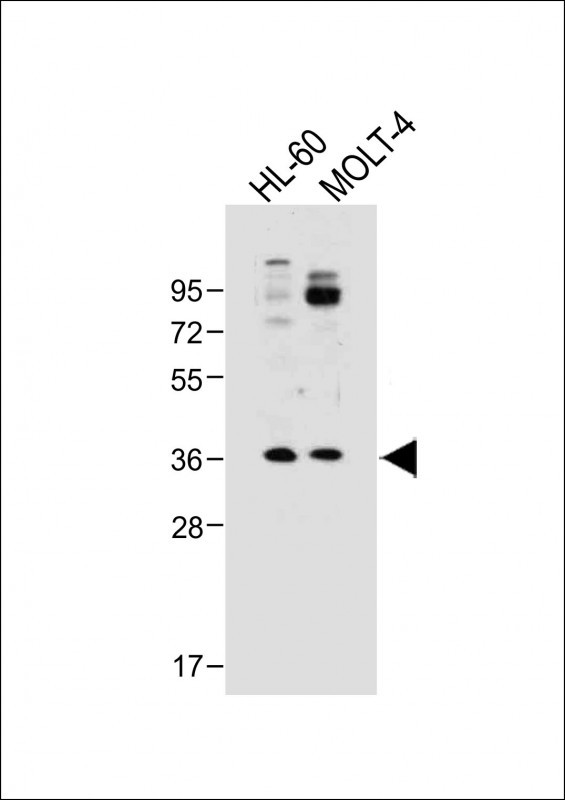RQCD1 Antibody (Center)
Affinity Purified Rabbit Polyclonal Antibody (Pab)
- SPECIFICATION
- CITATIONS
- PROTOCOLS
- BACKGROUND

Application
| WB, E |
|---|---|
| Primary Accession | Q92600 |
| Other Accession | Q6IP65, Q5PQL2, Q9JKY0, Q4R347, Q6NWL4, A7MB47, NP_005435.1 |
| Reactivity | Human |
| Predicted | Bovine, Zebrafish, Monkey, Mouse, Rat, Xenopus |
| Host | Rabbit |
| Clonality | Polyclonal |
| Isotype | Rabbit IgG |
| Calculated MW | 33631 Da |
| Antigen Region | 106-134 aa |
| Gene ID | 9125 |
|---|---|
| Other Names | Cell differentiation protein RCD1 homolog, Rcd-1, CCR4-NOT transcription complex subunit 9, RQCD1, CNOT9, RCD1 |
| Target/Specificity | This RQCD1 antibody is generated from rabbits immunized with a KLH conjugated synthetic peptide between 106-134 amino acids from the Central region of human RQCD1. |
| Dilution | WB~~1:500 E~~Use at an assay dependent concentration. |
| Format | Purified polyclonal antibody supplied in PBS with 0.09% (W/V) sodium azide. This antibody is purified through a protein A column, followed by peptide affinity purification. |
| Storage | Maintain refrigerated at 2-8°C for up to 2 weeks. For long term storage store at -20°C in small aliquots to prevent freeze-thaw cycles. |
| Precautions | RQCD1 Antibody (Center) is for research use only and not for use in diagnostic or therapeutic procedures. |
| Name | CNOT9 (HGNC:10445) |
|---|---|
| Synonyms | RCD1, RQCD1 |
| Function | Component of the CCR4-NOT complex which is one of the major cellular mRNA deadenylases and is linked to various cellular processes including bulk mRNA degradation, miRNA-mediated repression, translational repression during translational initiation and general transcription regulation. Additional complex functions may be a consequence of its influence on mRNA expression. Involved in down- regulation of MYB- and JUN-dependent transcription. May play a role in cell differentiation (By similarity). Can bind oligonucleotides, such as poly-G, poly-C or poly-T (in vitro), but the physiological relevance of this is not certain. Does not bind poly-A. Enhances ligand-dependent transcriptional activity of nuclear hormone receptors, including RARA, expect ESR1-mediated transcription that is not only slightly increased, if at all. |
| Cellular Location | Nucleus {ECO:0000250|UniProtKB:Q9JKY0}. Cytoplasm, P-body {ECO:0000250|UniProtKB:Q9JKY0}. Note=NANOS2 promotes its localization to P-body. {ECO:0000250|UniProtKB:Q9JKY0} |
| Tissue Location | Detected in spleen, thymus, prostate, testis, ovary and intestine. |

Thousands of laboratories across the world have published research that depended on the performance of antibodies from Abcepta to advance their research. Check out links to articles that cite our products in major peer-reviewed journals, organized by research category.
info@abcepta.com, and receive a free "I Love Antibodies" mug.
Provided below are standard protocols that you may find useful for product applications.
Background
Transcription factor that down-regulates MYB-and JUN-dependent transcription. May play a role in cell differentiation (By similarity). Can bind oligonucleotides, such as poly-G, poly-C or poly-T (in vitro), but the physiological relevance of this is not certain. Does not bind poly-A.
References
Ajiro, M., et al. Int. J. Oncol. 35(4):673-681(2009)
Miyasaka, T., et al. Cancer Sci. 99(4):755-761(2008)
Garapaty, S., et al. J. Biol. Chem. 283(11):6806-6816(2008)
Morita, M., et al. Mol. Cell. Biol. 27(13):4980-4990(2007)
Hiroi, N., et al. EMBO J. 21(19):5235-5244(2002)
If you have used an Abcepta product and would like to share how it has performed, please click on the "Submit Review" button and provide the requested information. Our staff will examine and post your review and contact you if needed.
If you have any additional inquiries please email technical services at tech@abcepta.com.













 Foundational characteristics of cancer include proliferation, angiogenesis, migration, evasion of apoptosis, and cellular immortality. Find key markers for these cellular processes and antibodies to detect them.
Foundational characteristics of cancer include proliferation, angiogenesis, migration, evasion of apoptosis, and cellular immortality. Find key markers for these cellular processes and antibodies to detect them. The SUMOplot™ Analysis Program predicts and scores sumoylation sites in your protein. SUMOylation is a post-translational modification involved in various cellular processes, such as nuclear-cytosolic transport, transcriptional regulation, apoptosis, protein stability, response to stress, and progression through the cell cycle.
The SUMOplot™ Analysis Program predicts and scores sumoylation sites in your protein. SUMOylation is a post-translational modification involved in various cellular processes, such as nuclear-cytosolic transport, transcriptional regulation, apoptosis, protein stability, response to stress, and progression through the cell cycle. The Autophagy Receptor Motif Plotter predicts and scores autophagy receptor binding sites in your protein. Identifying proteins connected to this pathway is critical to understanding the role of autophagy in physiological as well as pathological processes such as development, differentiation, neurodegenerative diseases, stress, infection, and cancer.
The Autophagy Receptor Motif Plotter predicts and scores autophagy receptor binding sites in your protein. Identifying proteins connected to this pathway is critical to understanding the role of autophagy in physiological as well as pathological processes such as development, differentiation, neurodegenerative diseases, stress, infection, and cancer.


